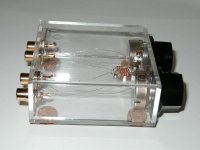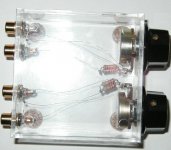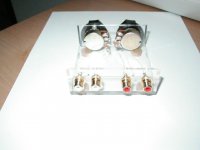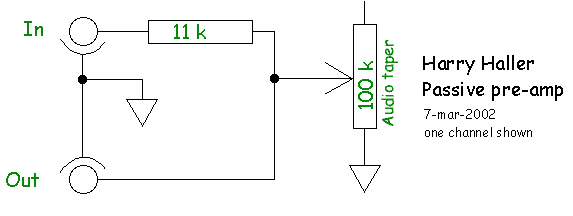To dispell the rumor that I am an over priced parts snob, I offer the following project. A passive preamp for under 20 dollars worth of parts from Radio Shack and your local arts and crafts or Container Store. Construction time is a couple of hours. Astonish your friends! Confound your enemies. Give one away at your next audio club meeting. Send it to school with your kid for show and tell. Spend the money you save on your wife for a change. This is a great sounding little project.
2.5 inch signal path with air dielectric
Dual mono
Silver solder and silver plated wire.
Series shunt design that sounds better than pot alone
Neutral tonal balance and transparent imaging
This is not a joke. April Fools day is weeks away. Any interest in construction details?
H.H.
2.5 inch signal path with air dielectric
Dual mono
Silver solder and silver plated wire.
Series shunt design that sounds better than pot alone
Neutral tonal balance and transparent imaging
This is not a joke. April Fools day is weeks away. Any interest in construction details?
H.H.
Attachments
Passive
No, the one I built has a series resistor (two 22Ks in parallel) connected between the signal pin of the input RCA jack and the wiper (center) leg of the pot. The output RCA jacks center pin is connected to the wiper leg of the pot. Only one of the other legs of the pot is connected to ground. The correct leg is the one that gives a very low resistance between the center leg and it when the pot is rotated fully counter-clockwise. The third leg of the pot is unconnected. So we have an 11K resistor between the signal pins of the input and output RCA jacks and the pot across the
signal to ground of the output RCA jack. The input and output jack are mounted next to each other for each channel. I left split washers out and soldered the ground wires directly to the threaded part of the RCA jacks. You could use the 2% silver solder if you are worried about melting the insulation on the jacks or plastic case. Sounds good, but not not as good as 4% silver solder but is much easier and lower melting point. I often tin the part with the 2% and finish with the 4%with very good results.
The pots are 100K audio taper Alphas from Radio Shack. The wire is 30 guage wire wrap wire with the insulation removed and the solder is 4% silver lead free, both also from R.S. I used box for displaying hockey pucks and cork feet from the Container Store.
I think the clear case adds to the transparency of the design. Okay that part was a joke but the innards are much cooler to look at than a hockey puck! I guess I am an audio voyeur. My audio designer friend and I send each other "Naked Amplifier Pics" from time to time. This is the most audio bang you can get for 20 bucks and is easy to build and find parts for. Sort of like Fast Food for gormet taste. I will be very dissapointed if this doesn't become an audio cult classic. Plug in those soldering irons, head to the Shack,and lets get some feedback on your results. I will try the Rod Elliot Passive for my next project and report on the results.
H.H.
http://sound.westhost.com/project01.htm
No, the one I built has a series resistor (two 22Ks in parallel) connected between the signal pin of the input RCA jack and the wiper (center) leg of the pot. The output RCA jacks center pin is connected to the wiper leg of the pot. Only one of the other legs of the pot is connected to ground. The correct leg is the one that gives a very low resistance between the center leg and it when the pot is rotated fully counter-clockwise. The third leg of the pot is unconnected. So we have an 11K resistor between the signal pins of the input and output RCA jacks and the pot across the
signal to ground of the output RCA jack. The input and output jack are mounted next to each other for each channel. I left split washers out and soldered the ground wires directly to the threaded part of the RCA jacks. You could use the 2% silver solder if you are worried about melting the insulation on the jacks or plastic case. Sounds good, but not not as good as 4% silver solder but is much easier and lower melting point. I often tin the part with the 2% and finish with the 4%with very good results.
The pots are 100K audio taper Alphas from Radio Shack. The wire is 30 guage wire wrap wire with the insulation removed and the solder is 4% silver lead free, both also from R.S. I used box for displaying hockey pucks and cork feet from the Container Store.
I think the clear case adds to the transparency of the design. Okay that part was a joke but the innards are much cooler to look at than a hockey puck! I guess I am an audio voyeur. My audio designer friend and I send each other "Naked Amplifier Pics" from time to time. This is the most audio bang you can get for 20 bucks and is easy to build and find parts for. Sort of like Fast Food for gormet taste. I will be very dissapointed if this doesn't become an audio cult classic. Plug in those soldering irons, head to the Shack,and lets get some feedback on your results. I will try the Rod Elliot Passive for my next project and report on the results.
H.H.
http://sound.westhost.com/project01.htm
Harry...the volume control arrangement you have...If I understand things correctly, are you are passing the signal to the amplifier through the resistors and controling volume by shunting some of the signal to ground through the pots?
Is this kind of arrangement as good as using a stepped attenuator?
Thanks
Is this kind of arrangement as good as using a stepped attenuator?
Thanks
Passive
Give the man a gold star. You got it.
It depends on the quality of the stepped attenuater contacts and resistors used. I hate the limited resolution for volume steps, the feel, and the COST of most stepped controls. I will put my 10K Caddock resistor/Alps100K Black Beauty Pot control up against any of them.
The pupose of this R.S. project was big bang for small bucks. I will post some other ones for deeper pockets later. Go build this one and you will be amazed at what the price of a good meal will get you. I use it with my hot rodded Aleph 3 and it sounds great. The point is to go try some easy projects and learn by listening. We can talk all day on forums but it won't tell you what something sounds like. This is a more sophisticated design than you might think. I have built more than a dozen passive preamps including a custom for a mainstream reviewer and I am not embassed by this Rad Shack design. Twenty dollars and a couple of hours is not a big investment to find out.....
H.H.
Give the man a gold star. You got it.
It depends on the quality of the stepped attenuater contacts and resistors used. I hate the limited resolution for volume steps, the feel, and the COST of most stepped controls. I will put my 10K Caddock resistor/Alps100K Black Beauty Pot control up against any of them.
The pupose of this R.S. project was big bang for small bucks. I will post some other ones for deeper pockets later. Go build this one and you will be amazed at what the price of a good meal will get you. I use it with my hot rodded Aleph 3 and it sounds great. The point is to go try some easy projects and learn by listening. We can talk all day on forums but it won't tell you what something sounds like. This is a more sophisticated design than you might think. I have built more than a dozen passive preamps including a custom for a mainstream reviewer and I am not embassed by this Rad Shack design. Twenty dollars and a couple of hours is not a big investment to find out.....
H.H.
You could still improve on that design by soldering resistors directly between input and output pins of RCA jacks. The length of signal path is the length of a resistor. Then run a wire from output pin to the wiper of the pot and connect the other pin of the pot to the ground. Since now you are using only 2 wires to the pots you might be tempted to use silver wire.
Passive revision
Blast! Out foxed by a brat from that damned Hogwart's school for troublemakers.... Actually its not a bad idea. You are eliminating 4 or five inches of wire. The signal path is still the same length since the pots are in the circuit in both cases. I could use silver wire, expensive pots, expensive RCA jacks.... you would have to order the parts after you deliberated on which parts, where to order them, maybe you should use a stepped attenuator? You think to yourself..... to much trouble, too much money, forget it for now, I'll do it some other time or maybe I'll post of few dozen post on audio forums and discuss it forever. Or you could go build it and find out how good it sounds. I have built the good stuff but that is not the audience this project is intendend for. I want people to think, 20 bucks, two hours, why not? I will post some more tweaked versions afer some actually builds this one. Robert
Prisig talks about gumption traps in "Zen and the Art of Motorcycle
Maintenance." Each journey begins with single step. Step on down to the Shack and check it out!
H.H.
And what is good, Phædrus,
And what is not good...
Need we ask anyone to tell us these things?
http://www.aoe.vt.edu/~ciochett/lit/zen.html
Blast! Out foxed by a brat from that damned Hogwart's school for troublemakers.... Actually its not a bad idea. You are eliminating 4 or five inches of wire. The signal path is still the same length since the pots are in the circuit in both cases. I could use silver wire, expensive pots, expensive RCA jacks.... you would have to order the parts after you deliberated on which parts, where to order them, maybe you should use a stepped attenuator? You think to yourself..... to much trouble, too much money, forget it for now, I'll do it some other time or maybe I'll post of few dozen post on audio forums and discuss it forever. Or you could go build it and find out how good it sounds. I have built the good stuff but that is not the audience this project is intendend for. I want people to think, 20 bucks, two hours, why not? I will post some more tweaked versions afer some actually builds this one. Robert
Prisig talks about gumption traps in "Zen and the Art of Motorcycle
Maintenance." Each journey begins with single step. Step on down to the Shack and check it out!
H.H.
And what is good, Phædrus,
And what is not good...
Need we ask anyone to tell us these things?
http://www.aoe.vt.edu/~ciochett/lit/zen.html
Scaling resistors for passive
You can play with values from 10K to 1K for a 20K to 10K pot. 1K will gve you a pretty low input inpedance at lower volume settings and 10K will give 6dB of loss at mminum attenuation. Lower impedances will interface better to cables. Life is series of compromises and there is no such thing as a free lunch.
H.H.
You can play with values from 10K to 1K for a 20K to 10K pot. 1K will gve you a pretty low input inpedance at lower volume settings and 10K will give 6dB of loss at mminum attenuation. Lower impedances will interface better to cables. Life is series of compromises and there is no such thing as a free lunch.
H.H.
Spots to buy pots
100KW Audio Taper Potentiometer
$1.99 Reg. Price Brand: RadioShack
Cat.#: 271-1722 Model: 271-1722
(Pricing and Availability may vary outside the contiguous 48 United States.)
Where to Buy
On-line Yes
In Stores Yes
1-800-THE-SHACK Yes
Wattage rating of 0.5W. Tolerance 20%. 6mm shaft. For projects and replacement. Mount in a 5/16"-diameter hole; includes nut and washer. 1 11/16" long x 1 1/4" diameter round shaft is easier cut to fit your application
H.H.
100KW Audio Taper Potentiometer
$1.99 Reg. Price Brand: RadioShack
Cat.#: 271-1722 Model: 271-1722
(Pricing and Availability may vary outside the contiguous 48 United States.)
Where to Buy
On-line Yes
In Stores Yes
1-800-THE-SHACK Yes
Wattage rating of 0.5W. Tolerance 20%. 6mm shaft. For projects and replacement. Mount in a 5/16"-diameter hole; includes nut and washer. 1 11/16" long x 1 1/4" diameter round shaft is easier cut to fit your application
H.H.
paulb said:Harry, can you supply the part no. of the potentiometer? Last time I looked, those nice pots that RS sells in the USA weren't available in Canada.
This is the one that popped into my head when i 1st saw Harry's post:
Pots - Page 1
look for 271-1732 100K STEREO POTENTIOMETER
I'd give you the URL to the actual product page, but they have written it so it only works in Exploder and i try to avoid that.
dave
Good work,
I can't see the point of removing the teflon insulation. The dielectric between the conductors will be as close to that of air as to not be an issue (1/10mm teflon, 10mm air). Remember that silver oxidises in air.
I just had a great thought that would truely make the preamp in another class. Remove the air!!!!!! Then the dielectric would be a vacuum (and you can't beat that), and the oxidisation issue would dissappear. It shouldn't be too difficult to make the box airtight, though the bearing on the pot will be a problem. (I have mental pictures of a vacuum line leading away to a vacuum pump in another room somewhere...)
Ahem... Back to reality.
Cheers, Adrian
I can't see the point of removing the teflon insulation. The dielectric between the conductors will be as close to that of air as to not be an issue (1/10mm teflon, 10mm air). Remember that silver oxidises in air.
I just had a great thought that would truely make the preamp in another class. Remove the air!!!!!! Then the dielectric would be a vacuum (and you can't beat that), and the oxidisation issue would dissappear. It shouldn't be too difficult to make the box airtight, though the bearing on the pot will be a problem. (I have mental pictures of a vacuum line leading away to a vacuum pump in another room somewhere...)
Ahem... Back to reality.
Cheers, Adrian
- Status
- This old topic is closed. If you want to reopen this topic, contact a moderator using the "Report Post" button.
- Home
- General Interest
- Everything Else
- Passive Preamp



